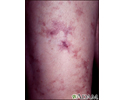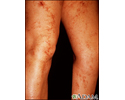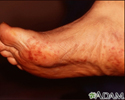Livedo reticularis
Cutis marmorata; Livedo reticularis - idiopathic; Sneddon syndrome - idiopathic livedo reticularis; Livedo racemosa
Livedo reticularis (LR) is a skin symptom. It refers to a netlike pattern of reddish-blue skin discoloration. The legs are often affected. The condition is linked to swollen blood vessels. It may get worse when the temperature is cold.
Causes
As blood flows through the body, arteries are the blood vessels that carry blood away from the heart and veins carry blood back to the heart. The skin discoloration pattern of LR results from veins in the skin that are filled with more blood than normal. This can be caused by any of the following:
- Enlarged veins
- Blocked blood flow leaving the veins
There are two forms of LR: primary and secondary. Secondary LR is also known as livedo racemosa.
With primary LR, exposure to cold, tobacco use, or emotional upset can lead the skin discoloration. Women 20 to 50 years old are most often affected.
Many different diseases are associated with secondary LR, including:
- Congenital (present at birth)
- As a reaction to certain medicines such as amantadine or interferon
- Other blood vessel diseases such as polyarteritis nodosa and Raynaud phenomenon
- Diseases that involve the blood such as abnormal proteins or high risk of developing blood clots such as antiphospholipid syndrome
- Infections such as hepatitis C
- Paralysis
Symptoms
In most cases, LR affects the legs. Sometimes, the face, trunk, buttocks, hands and feet are involved as well. Usually, there is no pain. However, if blood flow is completely blocked, pain and skin ulcers can develop.
Exams and Tests
Your health care provider will ask about your symptoms.
Blood tests or a skin biopsy may be done to help diagnose any underlying health problem.
Treatment
For primary LR:
- Keeping warm, especially the legs, may help relieve the skin discoloration.
- Do not smoke.
- Avoid stressful situations.
- If you are uncomfortable with the appearance of your skin, talk to your provider about treatment, such as taking medicines that can help with the skin discoloration.
For secondary LR, treatment depends on the underlying disease. For example, if blood clots are the problem, your provider may suggest that you try taking blood thinning medicines.
Outlook (Prognosis)
In many cases, primary LR improves or disappears with age. For LR due to an underlying disease, outlook depends on how well the disease is treated.
When to Contact a Medical Professional
Call your provider if you have LR and think it may be due to an underlying disease.
Prevention
Primary LR can be prevented by:
- Staying warm in cold temperatures
- Avoiding tobacco
- Avoiding emotional stress
References
Calonje E, Bren T, Lazar AJ, Billings SD. Vascular diseases. In: Calonje E, Bren T, Lazar AJ, Billings SD, eds. McKee's Pathology of the Skin. 5th ed. Philadelphia, PA: Elsevier; 2020:chap 16.
Jaff MR, Bartholomew JR. Other peripheral arterial diseases. In: Goldman L, Schafer AI, eds. Goldman-Cecil Medicine. 26th ed. Philadelphia, PA: Elsevier; 2020:chap 72.
Patterson JW. The vasculopathic reaction pattern. In: Patterson JW, ed. Weedon's Skin Pathology. 5th ed. Philadelphia, PA: Elsevier Limited; 2021:chap 9.
Review Date: 6/7/2023











